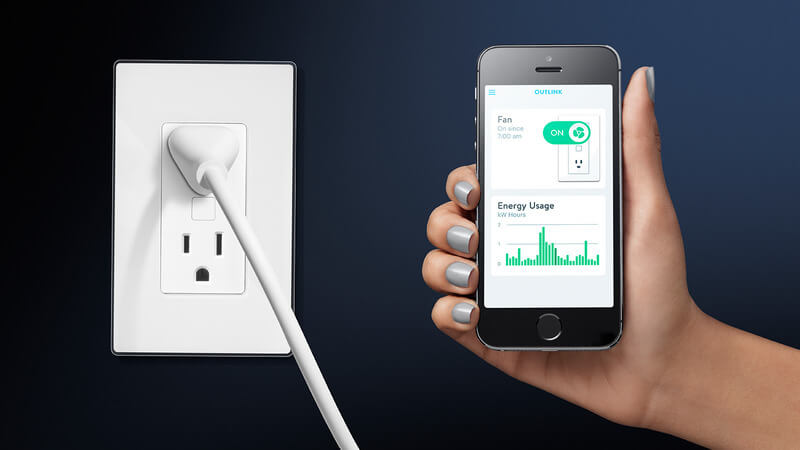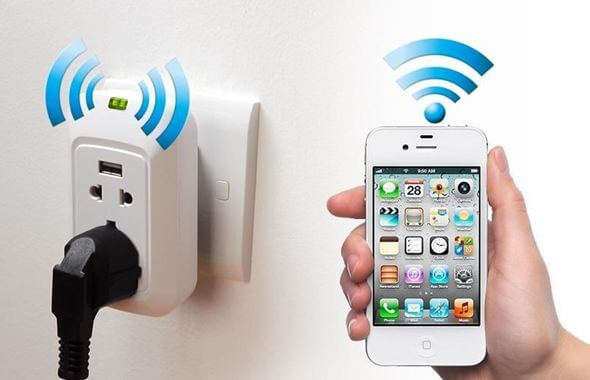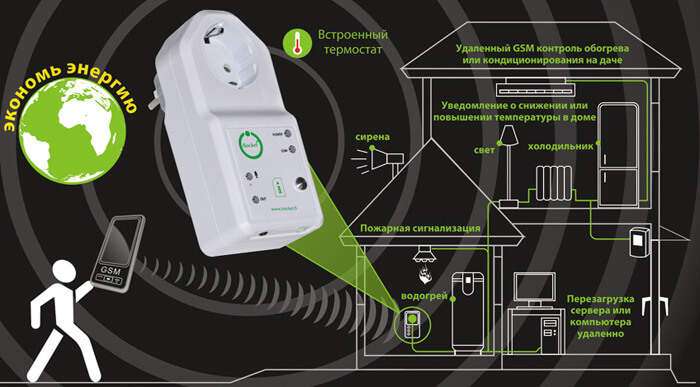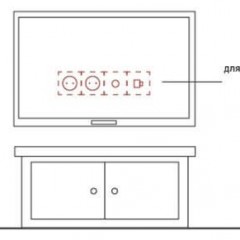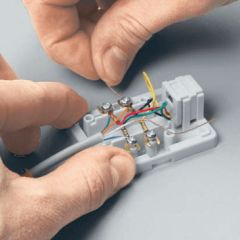How does a Wi-Fi outlet work and what are its advantages?
Varieties and characteristics
The principle of operation of wi-fi sockets of any type is exactly the same. As for the design, it is divided into two types: consignment note and built-in. The consignment note has the form of an adapter with one connector. The design of the device consists of such elements: the case itself, an indicator, a button, with which the device and the wi-fi module are turned on or off. The second option is an embedded module. Its purpose is to replace an ordinary electric point. The photo below shows both versions:
The principle of operation of two types is that due to the microprocessor that is inside the device, a connection is made with a control mechanism that regulates the on or off. But more complex models can also come across, which are produced as a surge protector, which has several connectors.
In addition, there are models that come with additional sensors that can be used to detect gas leaks, smoke or water leaks, and motion and temperature sensors.
Each wi-fi socket, depending on the manufacturer and model, has special technical characteristics. Manufacturing companies are constantly striving to improve their development and regularly make additions and innovations to it. The main differences are:
- originality in the design of the device and its packaging;
- quality of the material used;
- elements from which the product is made.
Wi-fi socket of any model consists of a body, which is made of heat-resistant plastic, and various elements that fill this body. The use of non-combustible materials helps to protect a person from the emission of harmful halogens. The heat resistance of the material is 748 degrees Celsius. Thanks to this, manufacturing companies guarantee the safety of wifi equipment.
Main functions
The purpose and scope of the Wi-Fi outlet is described in the following functions:
- turning on and off household appliances at a distance;
- thanks to the temperature sensor, the fire safety of the house is ensured;
- it is possible to control and recognize the readings of electricity that consume electrical appliances running on this device;
- if necessary, you can restart the equipment;
- control of children due to the presence of a timer, which turns off the TV or light after a certain time.
Terms of use
A Wi-fi socket, as a rule, operates in the range of an operating voltage of 100 - 240 V (meaning use in a home or office environment). The output power has its own interval, which is from 2 to 4 kW. Thanks to this, it is possible to connect devices with large short-term loads. For example, a heater, an electric kettle, or a food processor.
Despite the fact that all manufacturers create their own individual instructions for using the device, the principle of operation and their purpose are almost the same. The difference is only in the additional configuration of certain parameters and functions that a wi-fi socket has.
First you need to install a special application on your smartphone or tablet. Then check if there is a connection to your home wireless internet. On the box or in the device’s instructions there is a QR code with which you can access the software that you need to download.
After that, you need to find an option in the program that will search for a new wi-fi connection. Opposite the required wireless network, a window will appear in which you should enter the password for the connection. After confirming the password, the wi-fi socket is connected to a 220V network and is turned on by pressing the on / off button. The LED indicator will indicate that the wi-fi socket is ready for further work.
After all the settings are completed and the required functions are installed, you can connect any household appliance to the connectors and make individual settings for it. How to do this correctly is indicated in the instructions. If there is a need to reset all the settings to factory settings, then just press the on / off button for six seconds and the socket will return to its original position in which it was discontinued.
Advantages and disadvantages
The main advantage is that thanks to such a smart device you can control electrical appliances from a distance. Among the disadvantages, the following can be distinguished:
- If the power goes out, then all settings are reset and must be set again.
- There are models that are not compatible with the router. To fix this, you must call the master, as only his experience and knowledge will help to correct the situation.
- Wi-fi socket has its own time zone, which may not coincide with the real one. This is due to the fact that the device sets the time zone that the manufacturer has. This leads to self-tuning of the system.
- If an electrical failure occurs in the electrical network, the devices are automatically turned off.
- Changing the operation and functions of the device is possible only with one wireless network. If they are different, then this will lead to negative results.
- If there is no Internet connection, the device will not connect at the time specified in the settings. This is because all settings and changes are saved on servers that do not work without the Internet. But there is no special microchip that will include a memory block.
Finally, we recommend that you watch the video, which provides a detailed overview of the Wi-Fi outlet, as well as feedback on this type of design:
So we examined what a Wi-Fi outlet is, how this embodiment works and what are its advantages. We hope the information provided was useful and interesting for you!
We also recommend reading:

